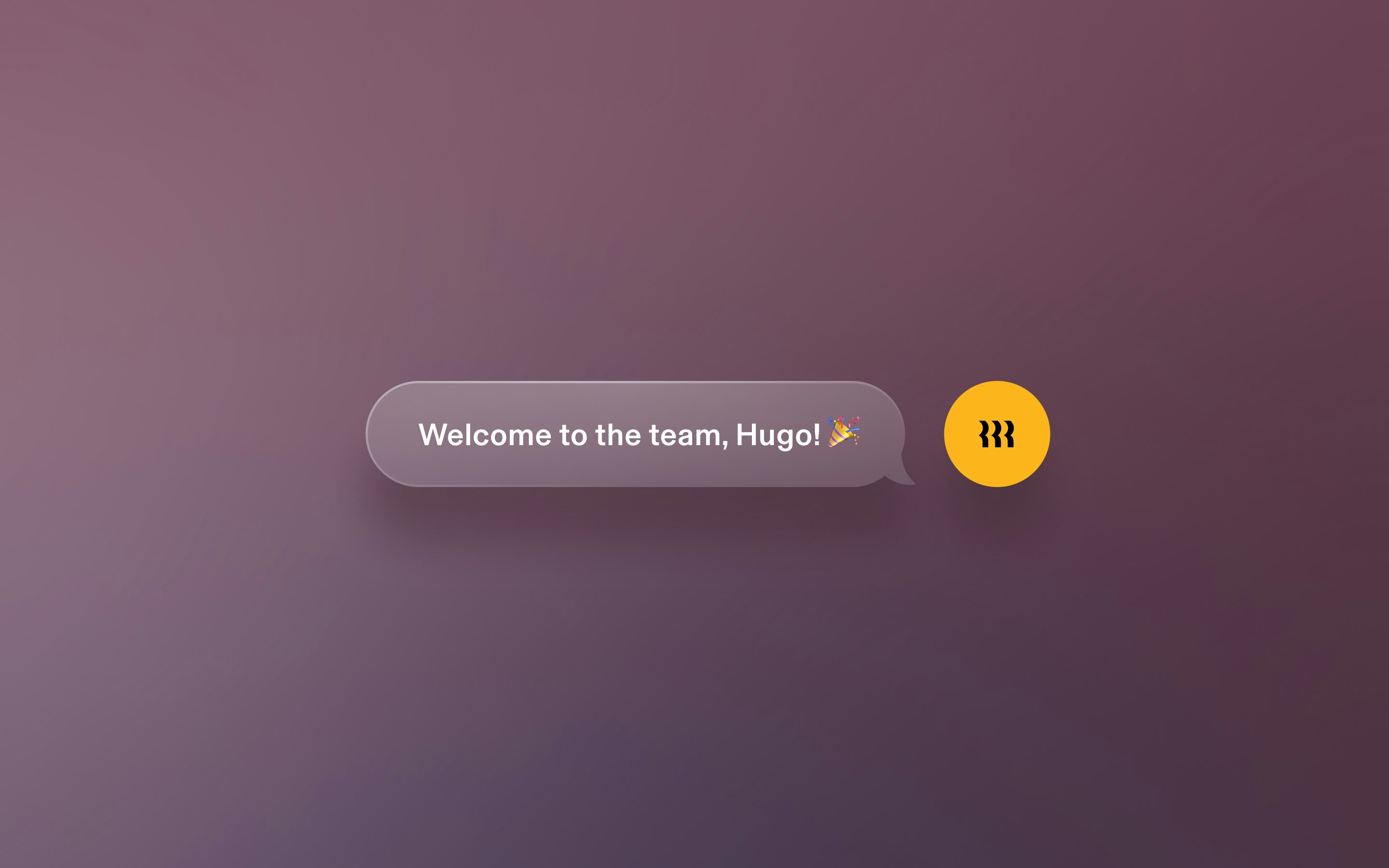30 Great welcome to the team message examples for new employees

When bringing on a new employee, a smooth onboarding process can provide many benefits: stronger relationships between teammates, higher levels of employee engagement, and increased productivity. One integral (yet often-overlooked) part of the onboarding process is writing a “welcome to the team” message.
While this might seem like a small detail compared to the rest of your onboarding checklist, a warm welcome aboard sets the tone for the relationship the new employee will build with their new team.
It’s one of the first things an employee will receive after they accept a job offer, so don’t underestimate its importance. And, with more people working remotely than ever, making sure your onboarding process is high quality is crucial for helping a new employee connect and engage.
In this guide, we’ll help you craft the perfect welcome note to new employees–including templates.
The importance of welcome messages for new employees
First impressions are everything. That goes for both the new hire and your company. When an employee starts their first day, you want to be sure they feel like they’re already a part of the team—and that they’re excited about their new career with you.
A warm welcome can achieve both of those things. It’s an especially crucial part of onboarding processes now that remote and hybrid work are common. Receiving a warm, friendly welcome note will let the newest member of the team know they’re not alone, even if they’re at home rather than in an office with all their coworkers. It also sets the tone for a positive employee experience.
Don’t worry if you aren’t sure exactly what should go into the message! It’s easy to worry about sounding too stiff and impersonal, or sending something that gives the new hire secondhand embarrassment. We’ve got you covered. Below, we’ll go over 30 examples of welcome messages to help you get started. Then, if you’d like to write your own, we’ll review the elements of an impactful welcome message and discuss everything it should include.
30 effective welcome message examples for different scenarios
Here are 30 ideas to help you get started writing your own “welcome to the team” messages, with short and longer instructional options to choose from:
10 examples to send to welcome new team members
- [Name], welcome to [company name] and congratulations on your new role as [job title]. We’re looking forward to incorporating your skills and experience, and we’re sure you’ll be a fantastic addition to the [name of department] team. See you on [start date]!
- [Name], just wanted to say we’re incredibly excited to have you on the team. We know starting at a new company can be a steep learning curve, so we’ll be introducing you to [coworker] on your first day. They’ll answer any questions and help you get to know the rest of the team.
- On your first day, please come prepared with all the paperwork we’ve included in this email, and review the materials we’ve sent to learn more information about [company name] ahead of time. Don’t hesitate to reach out to me if you have any questions.
- Welcome to the team, [name]. We were impressed by your dynamic, trailblazing approach throughout the whole interview process, and we can’t wait to have you on board.
- It’s great to have you join our team! We wanted to let you know you’ll be receiving an email with your login information, the names of your team members and their Slack info, and other relevant information you’ll need before your first day. In the meantime, don’t hesitate to ask if you have any questions.
- Congratulations, [name]! With your skills, experience, and vision, we know you’re going to fit right in at [company name]. Looking forward to your first day.
- On behalf of the whole team, I’d like to personally welcome you to [company name]. We’re thrilled to have you join our team and are truly energized by the impact we know you’ll have here.
- Hi [Name], Welcome to [Company Name]! We’re thrilled to have you join us. Looking forward to seeing all the great work we’ll do together come to fruition.
- Here’s some more information about next steps. When you start on [date], [coworker name] will be onboarding you and will introduce you to members of the team—especially [name] and [name], who you’ll be partnering closely with. [Coworker name] will reach out shortly with more details.
- Welcome to the crew, [Name]! We’re a friendly bunch, and we’re here to support you. Let’s do great things together!
5 welcome messages from CEO
- We are thrilled you’re embarking on the next step of your career with us, and we’re excited to have you on board for the next phase of [Company’s] growth.
- Welcome to the team, [Name]! I’m looking forward to all the incredible things we’ll accomplish together.
- I wanted to take a moment to personally welcome you to [Company Name]. We’re excited to have your talent on our side as we move into our next phase of growth. Welcome aboard!
- We’re incredibly excited to have you with us here at [Company Name]. Your journey with us starts today, and I have no doubt you’ll do amazing things. We’re looking forward to a bright future together!
- Welcome to our growing team, [Name]! I’m so pleased you’re joining [Company Name]! It’s people like you who drive our success, and I can’t wait to see how your expertise will help us continue to grow and innovate.
5 welcome messages from leadership
- I’m delighted to welcome you on board, [name]! Your outstanding portfolio and interviews impressed our team, and we know you’ll be a valuable asset to [company name].
- Hey [Name], We’re so glad you’re part of the team! Let us know if you need anything as you get settled in.
- Hey [Name], We’re thrilled to have you with us! We hope you’ll feel right at home here at [Company Name]. Looking forward to seeing you shine!
- Hello [Name], It’s an exciting time here at [Company Name], and I’m so glad you’re joining us. We know you’ll be a key part of our journey forward. If there’s anything I can do to help as you settle in, don’t hesitate to reach out.
- Welcome to the team, [Name]! At [Company Name], we value creativity, collaboration, and initiative. We’re confident you’ll fit right in and help us continue to grow. It’s a pleasure to have you with us.
5 welcome messages from HR team
- Delighted to have you on board, [name]. We hope you’ll feel right at home here. At [company name], we’re all about collaboration and support. We’ve attached a document that tells you more about our company and culture, and we’ll be adding you to our Slack channel soon so you can get to know all your team members. Looking forward to seeing you on your first day!
- We know that onboarding at a new company can be a lot to process, but the two main things to remember are:
- Your onboarding session. There’s already an invite in your calendar for your onboarding session on [date] at [time and time zone] to introduce you to our ways of working, company leadership principles, and other essential info to get you started.
- Your point of contact. [Coworker] (cc’ed) will be your main point of contact, so please feel free to email them with any questions you have and to arrange introductions with members of the team—especially [name] and [name], who you’ll be working with closely.
- Welcome to [Company Name], [Name]! We’re so happy you’re here! The HR team is always here to assist and help you settle in smoothly—feel free to reach out anytime.
- Hello [Name], It’s great to have you with us at [Company Name]! We’re here to make your onboarding experience smooth and enjoyable. Please look out for more info from our team closer to your start date and don’t hesitate to reach out in the meantime!
- Welcome to [Company Name]! Our team is here to help with anything you need as you get started. Look out for further details closer to your start date, but don’t hesitate to reach out with any questions in the meantime!
5 welcome messages from new manager
- It’s great to have you on our team, [name]! We’re excited to work with you, and we’re looking forward to hitting the ground running and getting your input on [name of key project]. I’ve attached your onboarding doc to help orient you—looking forward to discussing!
- So you’re well prepared for what to expect on your first day, please take some time to review the welcome packet attached to this email. Don’t hesitate to reach out if you have any questions; [name] (cc’ed) can answer any questions about the onboarding process.
- Welcome aboard, [Name]! We’re excited to have you on the team and can’t wait to start working together.
- Welcome to the team, [Name]! We’re so excited to have you onboard! Don’t hesitate to reach out with any questions as you settle in.
- A warm welcome to the team, [Name]! We know you’ll be an amazing asset, and the rest of the team is looking forward to meeting you soon! Let me know if you have any questions in the meantime and we’ll see you on [date and time]!
5 elements of an impactful welcome message
While the length of the welcome message is up to you, here are the goals it should achieve.
Convey company culture
Company culture is hugely important to today’s workforce—in fact, Forbes notes that businesses with a robust culture enjoy 72% greater employee engagement than those that do not have a clearly defined culture.
The welcome message is the perfect place to start showcasing your company culture. Is your workplace known for its team-focused culture? Make this clear by using collaboration-oriented language in your message and including a few of the upcoming activities your new hire will be included in. Are you all about transparency, openness, and support? Remind new employees they can bring up questions or suggestions right off the bat.
Communicate the role
As you welcome new team members, don’t forget to specifically state what the new hire’s official title is, as well as which department they’ll be a part of. This helps the employee see where they fit in the company’s overall structure. It also helps define your professional expectations of them, and sets the stage for the conversation they’ll have with their manager about their goals for the first 30, 60, and 90 days.
Show the new hire they’re valued
Showing new hires they’re appreciated is absolutely crucial to employee engagement, which, in turn, is related to productivity, employee retention, and even a strong company culture.
According to the SHRM, people who don’t feel valued by the business they work for are far more likely to quit, suffer stress-related issues that slow them down, or simply be entirely unmotivated. This is a nightmare scenario for businesses due to the high costs associated with constantly hiring and training new employees. Let the new employee know your company appreciates them and is proactive about showing it by demonstrating how much you value them right in that first welcome message.
Generate excitement about the new employee’s potential
Part of a positive employee onboarding experience is letting the new hire know you’re excited to see their work and impact. This can help motivate them as they kick off early workstreams. You might achieve this by mentioning a cool project or two they’ll be working on or saying something about the goals they’ll be helping the company achieve.
A welcome aboard message can also be what sets you apart from the competition. Some companies set themselves apart by sending welcome emails shortly after a candidate has received a job offer. In those cases, a welcome note to a new employee can be the determining factor in whether they accept a job offer from your company.
Introduce them to their new team and create relationships
Whether you choose to send the message by email or over Slack, make sure you include some actual information about the team they’ll be working with. This will help the new hire build relationships with their manager and colleagues and ensure they don’t feel like they’re on an island.
Some companies choose to set new hires up with one of their other staff members in a “buddy system.” Others prefer to let the employee know who they’ll be working with and let them know each of their coworkers will be reaching out on their own. However you do it, introductions are an essential way to integrate the new person into the team.
How to welcome a new team member
1. Use multiple channels to deliver a warm welcome
Don’t limit a welcome note to new employees to one platform. While a welcome email can go a long way, it’s always encouraged to introduce a new employee to their new team with a group welcome message or “team channel” on company messaging apps such as Slack or Teams.
This can invite team members to easily hop onto a “welcome aboard” thread and extend a warm welcome in a relaxed and open forum.
2. Highlight the company culture and values early on
By introducing your organization’s mission, values, and culture right from the beginning, you can help new hires understand what drives the company and increase their employee engagement from day one. New managers can introduce new hires to company culture by including helpful materials in their welcome email: employee handbooks, a calendar of employee engagement activities, and links to employee resource groups. When new employees grasp the organization's culture early on, they are more likely to feel connected, motivated, and able to contribute in meaningful ways.
3. Provide practical details about the first day and beyond
In addition to providing crucial information in a welcome email prior to a new employee’s start date, an employee orientation can be the most effective way to help a new employee get up to speed on their new role. It’s usually a structured, one-time introduction to your company, typically occurring on the new hire’s first day or within their first few weeks.
HR teams use orientation days to formally welcome new team members in a digestible, relaxed setting, with ice breakers and refreshments.
4. Introduce the new hire to the team
Make sure new employees meet their new team on the first day. Set up a team meeting or lunch to make them feel welcome aboard, and to connect them with the coworkers they’ll collaborate most with. Whether you’re taking your new employee around the office to meet the team, or you’re extending a warm welcome on Slack, a welcome note to new employees always goes a long way.
5. Reinforce support systems for the new employee
In addition to the new team members they meet at orientation, some companies implement mentorship programs to help new employees learn from more tenured employees. A buddy system pairs a new employee with a more experienced employee–or mentor–to help them adjust to their new job.
6. Schedule check-ins
Onboarding doesn’t end in the first week or two. Set your new employee up for success by keeping a clear line of communication. Regular one-on-one check-ins can create a strong manager-employee rapport and ensure new hires are engaged. Additionally, setting meetings at 30, 60, and 90 days to check in on big-picture progress can support employees as they ramp up.
H2: Enhance your onboarding process with Rippling
If you want to create a smooth onboarding process that results in a positive employee experience, Rippling can help.
Rippling simplifies and automates your onboarding work by triggering alerts and actions off of any data you have within the platform. You can automate manual onboarding tasks such as sending welcome emails and new laptops before a new employee’s start date, communicating work authorization or shipping delays, flag benefit enrollment deadlines, and even alert team members when a candidate accepts their job offer—so they can make sure they send a warm “welcome to the team” message.
Rippling automation saves hours of manual work and ensures that your employees have the best possible onboarding experience. It has everything you need to onboard new hires—whether they’re remote, hybrid, working in the office. See how Rippling can level up your onboarding process and delight employees—schedule a demo today.
Disclaimer: Rippling and its affiliates do not provide tax, accounting, or legal advice. This material has been prepared for informational purposes only, and is not intended to provide or be relied on for tax, accounting, or legal advice. You should consult your own tax, accounting, and legal advisors before engaging in any related activities or transactions.









